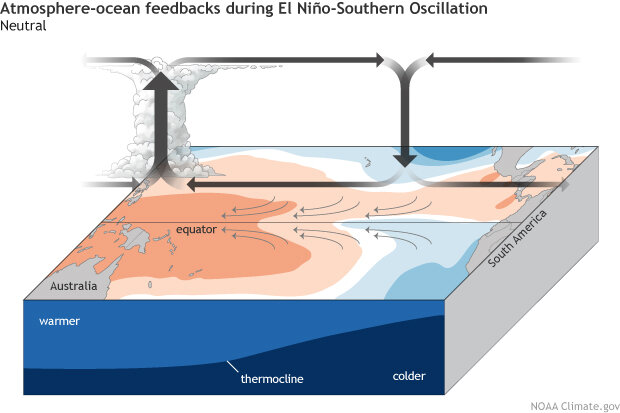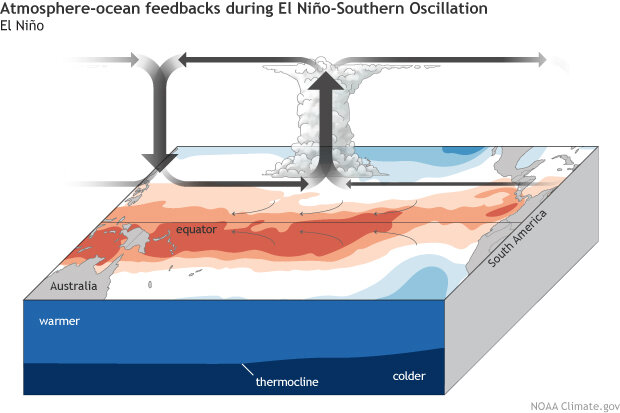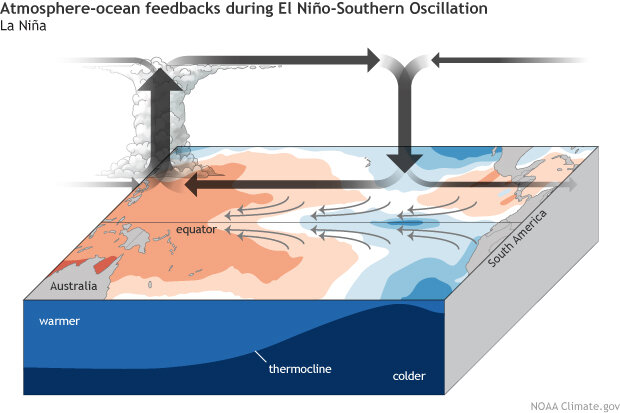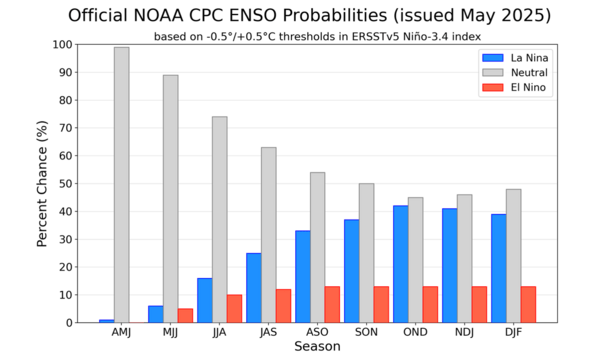The Powerful Forces Behind El Niño and La Niña
3 min read
El Niño and La Niña are powerful climate phenomena that significantly influence ocean currents and global weather patterns. Understanding their effects is essential for sailors, meteorologists, and anyone impacted by shifting climate conditions around the world.
The El Niño–Southern Oscillation (ENSO) is one of the most powerful natural cycles on Earth, dramatically altering winds, surface currents, ocean temperatures, and even the position of the jet streams. This shifting system unfolds across the tropical Pacific Ocean, stretching from the west coast of South America to Australia and Indonesia.
Normally, this region is driven by steady trade winds blowing from east to west, pushing warm surface waters toward the western Pacific and allowing cooler waters to upwell along the coast of Peru and Ecuador. But these trade winds, and the currents they drive, aren’t constant. Every 2–7 years, the system destabilizes, shifting into one of two distinct modes: El Niño or La Niña.
🌤️ Neutral Phase - “The Baseline”
Trade winds blow steadily east to west across the equator.
Warm surface waters accumulate in the western Pacific (near Indonesia and Australia).
The eastern Pacific (off South America) experiences upwelling of cold, nutrient-rich water.
The thermocline (the boundary between warm surface water and colder deep water) slopes from west (deep) to east (shallow).
Atmospheric convection (clouds and rainfall) is strongest over the warm water in the west.
Result: Balanced climate patterns. Regular monsoon seasons in Asia, productive fisheries off South America, and typical weather worldwide.


🔥 El Niño - “The Warm Phase”
El Niño develops when the trade winds weaken or even reverse. This disruption allows the warm water in the western Pacific to flow eastward, sloshing across the ocean and spreading toward the coasts of South and Central America.
Warm water suppresses upwelling off South America, shutting down nutrient supply and harming fisheries.
The thermocline flattens, reducing cold water input across the basin.
Rainfall patterns shift eastward, bringing floods to Peru and Ecuador, but drought to Indonesia, Australia, and parts of Southeast Asia.
The eastern and central Pacific become warmer than average, sometimes by 2–3°C.
The global atmosphere reacts: Jet streams shift, changing storm tracks around the world.
Global impacts:
Wetter winters in the southern U.S. and western South America
Drier conditions in Australia, Indonesia, and parts of Africa
Fewer Atlantic hurricanes (due to increased wind shear)
Coral bleaching due to sustained warm ocean temperatures
Sailor’s note: Expect less predictable trade winds, unusual current flows, and disrupted swell patterns across the Pacific.


❄️ La Niña - “The Cool Phase”
In contrast, La Niña occurs when trade winds strengthen beyond normal, pushing even more warm surface water into the western Pacific.
The eastern Pacific sees enhanced upwelling of cold water, resulting in colder-than-average sea surface temperatures.
The thermocline steepens sharply, with a strong east-west tilt.
Atmospheric convection shifts even further west, leading to heavier rains and flooding in Southeast Asia and Australia, but dryness in the eastern Pacific.
Global impacts:
More hurricanes in the Atlantic basin
Colder, stormier winters in the Pacific Northwest
Drought conditions in the southern U.S. and western South America
Enhanced productivity for fisheries off Peru and Chile
Sailor’s note: Expect stronger trade winds, accelerates westward currents and rougher weather in the western Pacific.


CREDIT: NOAA View
In June 2025 NOAA Climate Prediction Center forecasts with high confidence (82%) that the tropical Pacific will remain in ENSO‑Neutral through Summer 2025 and into early 2026, though there's a notable 41% chance of a weak La Niña during the Winter 2025–26 period.


CREDIT: NOAA Climate Prediction Center
If you’d like to read more, follow our journey, and support what we do, don’t forget to subscribe to our newsletter or follow us on social media. Every bit of encouragement helps keep the adventure going and we’d love to have you aboard!
